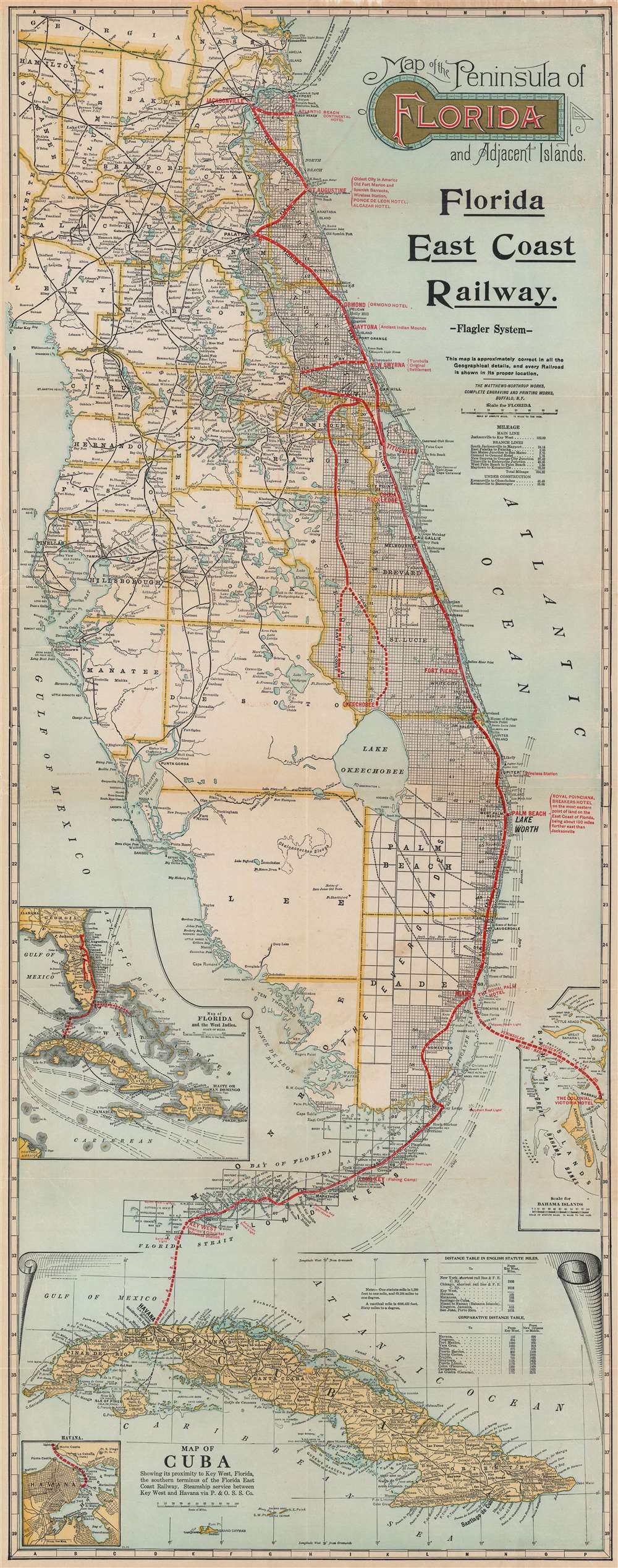
This item below is out of stock, but another example (left) is available. To view the available item, click "Details."
Details
1914 Florida East Coast Railway Railroad Map of Florida
1914 (dated) $1,200.00
1912 Florida East Coast Railway Railroad Map of Florida
FloridaEastCoastRail-matthewsnorthrup-1912
Title
1912 (undated) 40 x 16 in (101.6 x 40.64 cm) 1 : 887000
Description
The Florida East Coast Railway
The Florida East Coast Railway was a major force in the development of Eastern Florida in the late 19th and early 20th century. Spearheaded by the industrialist Henry Flagler, the Florida East Coast Railway fulfilled a vision dating back at least to the 1870s. Before Flagler, Florida south of Jacksonville was serviced by only a few rickety old railroads unconnected to one another. Most access to Florida cities was limited to ferry and steamer services. Flagler bought up most of the failing existing railroads, upgraded them, and connected them with new lines, formally consolidating the network first as the Jacksonville, St. Augustine, and Indian River Railway, and then, on September 9, of 1895, as the Florida East Coast Railway.The railroad reached New Smyrna in 1892, Cocoa in 1893, Palm Beach in 1894, and Miami in 1896. Flagler constructed sumptuous resorts and founded cities all along the route, among them The Ormond, the Royal Palm, the Royal Poinciana, the Continental, and more. Combined with his railroads, and the Peninsular and Occidental Steamship Company (P. and O. S.S.), Flagler commanded a resort empire spanning the entire east cost of the Florida peninsula.
The extension to Key West, possibly the greatest Railroad achievement of the era, was planned from about 1895, but not completed until 1912. It operated for little more than 20 years, heralding a golden age for the Florida Keys and Key West in general. Business magnates, presidents, and dignitaries rode the rails to Miami or Key West before embarking on Flagler’s Peninsular and Occidental Steamship Company to Havana, Cuba, and the Bahamas. Long after Flagler’s death, the Labor Day Hurricane of 1935 destroyed some of the railroad bridges leading to Key West (the remains of which can still be seen) and the FEC, then insolvent, was unable to finance the repairs. The tracks were donated to the state, who used the infrastructure to construct the Overseas Highway (U.S. 1).
Census and Publication History
There are multiple states of this map reflecting the development of the Florida East Coast Railway. The present example is the only representative of this specific state we have been able to identify. The Library of Congress owns the earliest known example, published for the Jacksonville, St. Augustine, and Indian River Railway, with the railroad terminating at Palm Beach, and a date of 1893. Rumsey’s example of 1896 sees the name changed to Florida East Coast Railroad, and shows tracks extending as far as Miami, with planned extensions as far as Key West. An example at Yale dating to 1906, shows various proposed extensions, in addition to Key West as well as planned ferry services to Cuba and the Bahamas. The Tampa Bay History Center, Touchton Map Library, owns an example showing the track extending as far as Key West dating to 1912. The present example is similar to the Touchton 1913 example, except where he Touchton example exhibits black and white printing to name lighthouses and buoys, here they are overprinted in red, suggesting a slightly earlier state. A more extensive version was published by the Florida Land Department in 1924, showing all railroads and roads in the peninsula.Cartographer
Matthews-Northrup Works (fl. c. 1895 - 1930) were a Buffalo, New York based, in their own words, "writing, designing, engraving, printing, [and] binding" firm. The firm was founded by James Newson Matthews (November 21, 1828 - December 20, 1888) as the J. N. Matthews Company. William Phelps Northrup (April 2, 1850 - February 2, 1929) later joined the company as an apprentice and then partner, at which point the firm was reincorporated as the Matthews-Northrup Works. The Matthews-Northrup Works rose to prominence as publishers and printers of railroad maps, with dozens to their credit. When James died, his shares were inhered by George Edward Matthews (1855 - 1910), who ran the business until his death in 1910. Also in 1910, they famously redesigned the cover of National Geographic Magazine. Despite some six previous cover changes in just 21 years, the Matthews-Northrup layout proved so popular that it was used for nearly 50 years. The firm can also take credit for the Winchell typeface, designed in 1903 under E. E. Winchell's tenure as art director. Curiously, the partners of Matthews-Northrup maintained an unusual affectation in which only the officers of the company could wear beards or mustaches. In this same spirit, the firm also had its own private social club, the Fellowcraft Club, where the all-male employees could relax, play pool, drink and dine. Matthews-Northrup maintained offices on Washington Street, Buffalo, where they were based, as well as Madison Square, New York City, Garden Tower, Boston, and the Citizens Building in Cleveland. More by this mapmaker...

